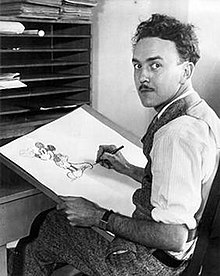
Back أب أيوركس Arabic اب ايوركس ARZ Ub Iwerks Catalan Ub Iwerks Czech Ub Iwerks Danish Ub Iwerks German Ουμπ Άιγουερκς Greek Ub Iwerks Esperanto Ub Iwerks Spanish Ub Iwerks Basque
Ub Iwerks | |
|---|---|
 Iwerks animating his most famous co-creation, Mickey Mouse c. 1929 | |
| Born | Ubbe Ert Iwerks March 24, 1901 Kansas City, Missouri, U.S. |
| Died | July 7, 1971 (aged 70) Burbank, California, U.S. |
| Resting place | Forest Lawn – Hollywood Hills Cemetery |
| Occupations |
|
| Years active | 1919–1971[1] |
| Employers |
|
| Notable work | |
| Spouse |
Mildred Sarah Henderson
(m. 1927–1971) |
| Children | 2, including Don Iwerks |
| Relatives | Leslie Iwerks (granddaughter) |
| Signature | |
Ubbe Ert Iwerks (March 24, 1901 – July 7, 1971), known as Ub Iwerks (/ˈʌb ˈaɪwɜːrks/ UB EYE-wurks), was an American animator, cartoonist, character designer, inventor, and special effects technician, known for his work with Walt Disney Animation Studios in general, and for having worked on the development of the design of the character of Mickey Mouse, among others. Born in Kansas City, Missouri, Iwerks grew up with a contentious relationship with his father, who abandoned him as a child. Iwerks met fellow artist Walt Disney while working at a Kansas City art studio in 1919.
After briefly working as illustrators for a local newspaper company, Disney and Iwerks ventured into animation together. Iwerks joined Disney as chief animator on the Laugh-O-Gram shorts series beginning in 1922, but a studio bankruptcy would cause Disney to relocate to Los Angeles in 1923. In the new studio, Iwerks continued to work with Disney on the Alice Comedies as well as the creation of the Oswald the Lucky Rabbit character. Following the first Oswald short, both Universal Pictures and the Winkler Pictures production company insisted that the Oswald character be redesigned. At the insistence of Disney, Iwerks designed a number of new characters for the studio, including designs that would be used for Clarabelle Cow and Horace Horsecollar.
One of Iwerks' most long-lasting contributions to animation was a refined version of a sketch drawn by Disney that would later go on to become Mickey Mouse. Iwerks was responsible for much of the animation for the early Mickey Mouse and Silly Symphony cartoons, including Steamboat Willie, The Skeleton Dance and The Haunted House, before a falling out with Disney led to Iwerks' resignation from the studio in January 1930. Iwerks' final Mickey Mouse cartoon was 1930's The Cactus Kid. Following his separation with Disney, Iwerks, operating under Iwerks Studio, created the characters Flip the Frog and Willie Whopper along with the ComiColor Cartoons series as part of a contract with Metro-Goldwyn-Mayer, but the new studio failed to rival its competitors. Iwerks later directed two Looney Tunes cartoon shorts for Leon Schlesinger Productions and several Color Rhapsody cartoons for Screen Gems before joining Disney again in 1940, after which he worked with special visual effects on productions such as 1946's Song of the South.
Iwerks had two children, Donald Warren Iwerks and David Lee Iwerks, with his wife Mildred Sarah Henderson. Iwerks died of a heart attack in Burbank, California, in 1971 at age 70. Iwerks was posthumously named a Disney Legend in 1989. His likeness has been featured in his granddaughter Leslie Iwerks' 1999 documentary The Hand Behind the Mouse: The Ub Iwerks Story as well as the 2014 feature film Walt Before Mickey, in which he is portrayed by Armando Gutierrez. Iwerks received three nominations at the Academy Awards, for which he won one. He also posthumously received the Winsor McCay Award at the 1978 Annie Awards and the Hall of Fame award at the 2017 Visual Effects Society Awards.
- ^ Korkis, Jim (July 1, 2020). "Who Was Ub Iwerks?". Archived from the original on May 6, 2022. Retrieved May 2, 2022.
- ^ "'Minitoons' from Cartoon Films LTD/ Animated Cartoons Inc". April 7, 2016. Archived from the original on May 2, 2022. Retrieved May 2, 2022.
- ^ "Mildred Sarah Henderson 1899–7 July 1971 (Age 72)". FamilySearch. Retrieved February 22, 2023.